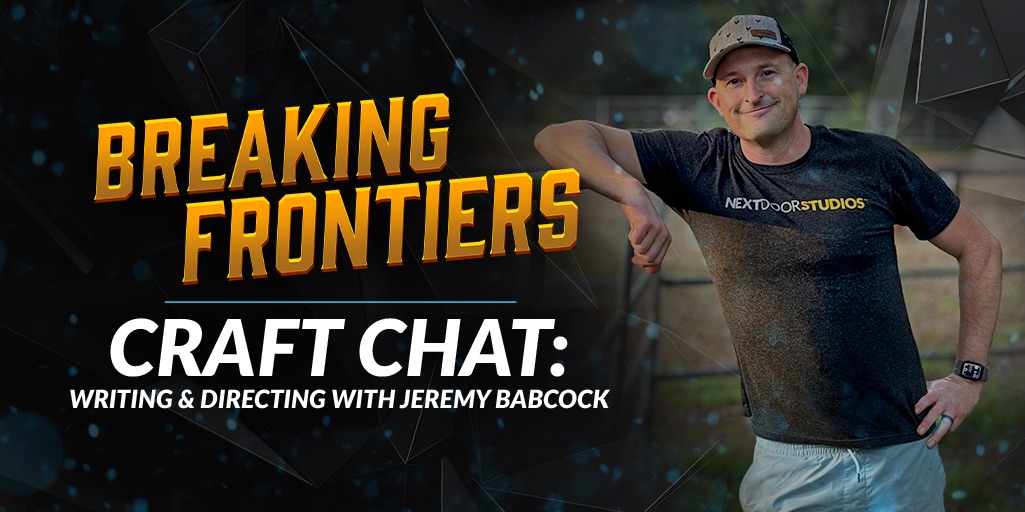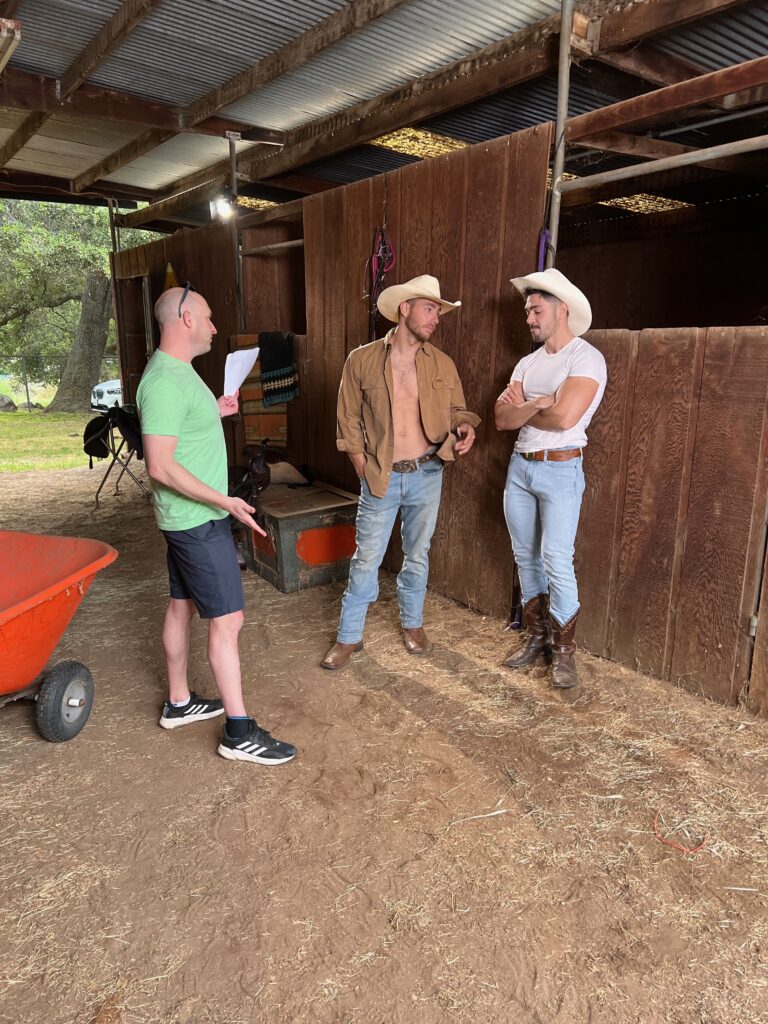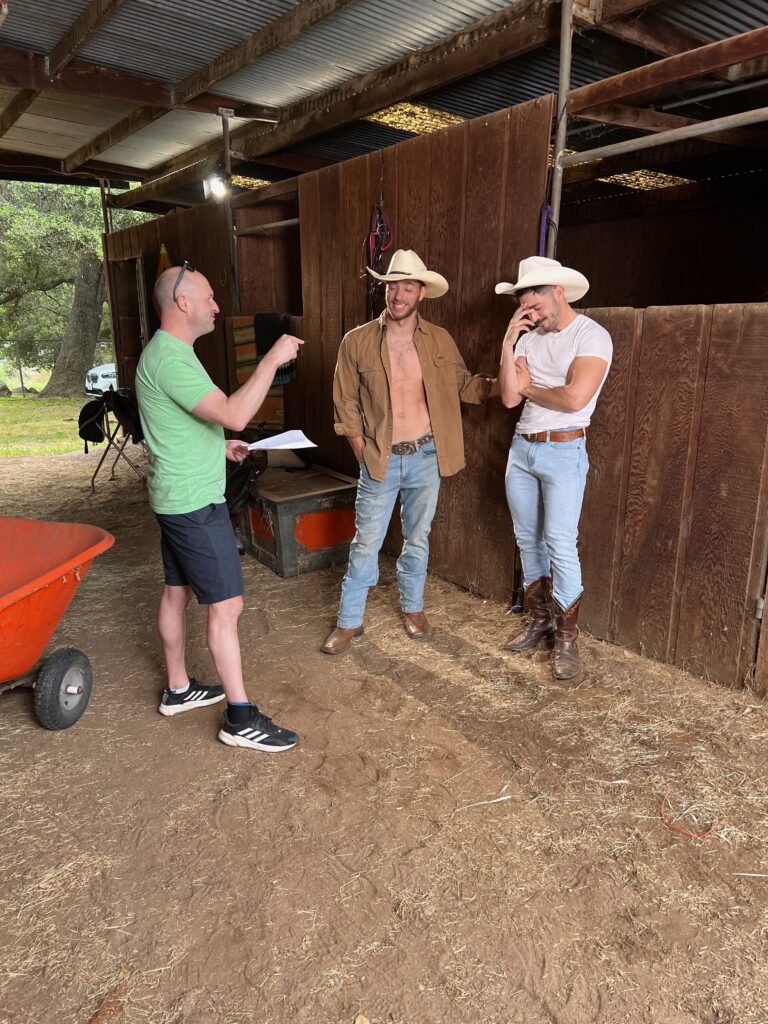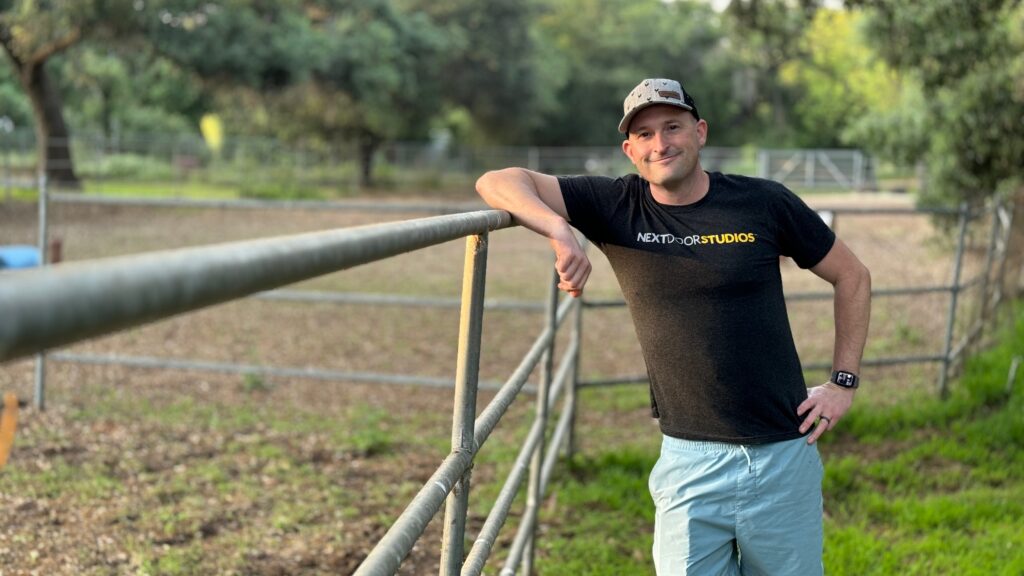
Jeremy Babcock is a man who wears many hats at ASGmax. As a Chief Creative Officer, producer, director, and writer, Babcock is a busy man. We had the opportunity to sit down with him to discuss his latest film Breaking Frontiers. Viewing the film from a writing perspective, Babcock gave us insight into how an idea becomes a great film.
How did you create depth and complexity in the characters?
Once a script is written, I always go back over everything and look for logic holes and weak characters. Especially for gay porn, I think it’s super important for each character to be somebody a viewer can relate with. I think even the smallest side character should have a reason to exist and a motivation to have sex.
What techniques did you use to reveal character traits and development through dialogue and actions?
It’s pretty common for me to add little notes into chunks of dialogue to note whether a character is nervous, smiling, joking, etc. I like to leave scripts open enough for the models to find their version of the character, but also specific enough that they can understand the goal of each moment in the film.
How do you ensure that each character’s motivations are clear and compelling?
I’m a big believer in “show, don’t tell.” I like to keep dialogue quippy and concise so that the real magic comes through in the body language and pacing of a scene. It’s also so much easier for a model to deliver quick lines than to have to deliver long runs. I want their actions and delivery to feel authentic and not rehearsed.

What was your approach to writing the character arcs for Carter, Cody, JC, and Nico?
It takes several rewrites and revisions to get to a point where each character feels like they have a reason to exist in the film. In this case, Carter needed to feel true to the character from “That Summer”, but also have a sense of growth and evolution as each part of this film unfolds. There are some really nice call-backs to That Summer that show Carter’s character taking control of his actions and being more comfortable with himself this time around. Cody and JC have really similar arcs, but with different perspectives. Cody is the gay character surrounded by all these “straight” guys, while JC is one of the boys, yet both characters find themselves in the role of matchmaker when they see a bond between Carter and Nico. Then Nico’s role as Carter’s best friend gave a lot of opportunities to unfold a bromance that’s rooted in friendship before feelings. The dynamic between Carter and Nico is really complex and fun to watch over the course of the 4 films. Across the board, though, I always try to write FOR each model. I want these characters to feel lived-in and comfortable, so I like to take real characteristics from each model and incorporate them in to the story.
How do you balance character consistency with the need for growth and change throughout the screenplay?
This part sometimes feels easy for porn. Our arc is basically what causes these two people to come together sexually. The characters all get to be true to who they are, while exploring some new sexual “frontiers.”
How did you outline the screenplay to ensure a coherent and engaging plot?
I map it all out first. I outline the story I want to tell and how each character weaves in and out of each other’s story. I want everyone to feel authentic and real, and our audience tends to find the engagement in their personal connection to any given character’s story.
What methods did you use to develop the plot twists and surprises in the story?
When you click on a scene, you already know WHO is going to have sex, so our real challenge is finding a compelling WHY. We have a small window, but I really like to set up the characters, identify an obstacle, and then the surprise is how they work past that obstacle.
How did you determine the pacing of the screenplay to maintain tension and interest?
I like to work through several locations and keep each section fairly succinct. Each piece of the script needs to work hard to push a piece of the story. In all of the Next Door Films scenes, one mainstay is finding ways to break up the dialogue with eye candy and sexy moments. I love to further a story through a fun montage, to break up the drama and see the guys having fun and connecting with each other.
How do you weave subplots into the main narrative without overshadowing the central story?
I think of each character’s journey as the sub-plot. By giving each character a reason to exist, we ultimately have 5 stories weaving together to make up the central plot. Our central story really IS the combination of the subplots.
What strategies did you use to keep the audience invested in the characters’ journeys?
By keeping the characters grounded in reality and authenticity, we give our audience the broadest chance to connect. Have they struggled with their sexuality? Have they lusted after somebody who they couldn’t have? Have they had a friend who felt like ‘more’ than a friend?
How do you craft dialogue that feels natural and authentic to each character?
I really like to write for the models. Having known some of these guys for years, it’s really fun to give them characters that feel personal to them. From there, it’s highly encouraged for the guys to adlib their lines, and make them feel natural. Some of our best magical moments come when the guys insert their own lines while living in the moment.
What techniques do you use to differentiate the voices of different characters?
For us, that goes back to the casting phase. I want to bring in guys who fit the characters I want in the story. From there, I get to lean in to their natural charm and charisma to differentiate. In this film, the country accents are a pretty literal way their ‘voices’ came out differently.
What role does subtext play in the dialogue between characters, especially in scenes of tension and revelation?
I think subtext is everything. Slowly building sexual chemistry through actions and mannerisms and little hints in the dialogue is what makes these films shine. That little flirty touch early in the film can really pay off later.
How do you use dialogue to reveal backstory and character relationships?
This film really revolves around backstory. Carter’s evolution from That Summer, then this new backstory of Cody as ranch hand, Andrew as horse caretaker, and JC and Nico as high school buddies. All these little pieces work to make the current situations more authentic and real.
How does the physical environment of the ranch influence the characters and their interactions?
The rural setting gives a different world of context for the characters. Being “gay” in that environment is not as universally accepted and gives a lot of context for the characters being more reserved in their actions and intentions.


How do the characters’ relationships reflect broader societal themes or issues?
Same as above. This notion of friends from a rural area gives a pressure to be more masculine and not embrace the sexual fluidity that might be more common in other areas. It gives their stories and evolution a different sense of importance within their microcosm.
How do you approach writing the opening scene to grab the audience’s attention?
Each part of Breaking Frontiers opens with a bit of voiceover delivered by each character in the scene. These stories unfold slowly, so it’s nice to have a little tease for the theme of each part up front. It’s a fun hook that gives us some context that can apply in different ways for different characters.
What techniques do you use to build and sustain tension in key scenes?
The most common thing you’ll hear me say on set is “SLOW IT DOWN.” Shake the nerves, let the lines feel personal, deliver them with meaning instead of spitting out the words. The slower the conversations unfold, the more heart and tension we’ll be able to layer in. Again, ‘show, don’t tell’.
How do you craft scenes of emotional climax and resolution?
If I do my job right, that first kiss before sex is where our emotional climax begins, then… well… the physical climax becomes our resolution. I love for each scene to end with a little piece of story. I want to see the moments or days after sex. How that’s affected their relationships and how that can affect the other character’s stories.
How do you transition between scenes to maintain a seamless flow in the narrative?
(mentioned above) I’ll almost always use the final scene to tie up some loose ends and then set up some complications for our next installment. I like to leave the viewer satisfied, but with an interest in seeing where the story goes next.
What role do visual and auditory elements play in your scene construction?
I try to build a lot of my scripts and films around the balance of dialogue with captivating visuals and sounds. As a former editor, I approach films with an idea of how the pieces will come together in Post, and I like to build in segments that give builds of energy that make the quiet parts more thoughtful, and the louder parts bigger. As a huge music fan, I want the films to feel fun and modern and vibrant. I think compelling tracks really enhance that enjoyment and connection to the film. The editor on these films did an AMAZING job finding tracks that fit the country theme without feeling like a western.
How do you approach the revision process to refine your screenplay?
Casting kept changing on this film up until about 3 days before we started shooting. This was a monumental task in keeping details straight, but still keeping storylines intact. With 4 pieces to connect, there are a lot of loose ends you’ll find along the way. The real puzzle becomes finding those loose ends, and finding a creative, fun, sexy way to bring them back around. Special shout out to Micah Martinez for helping me with this phase of the project. When my head was spinning, Micah was able to help me sort through the chaos and pull everything back together – especially on Part 3, our only piece that included all 5 characters.
What feedback do you seek during the editing process, and how do you incorporate it?
As a former editor, I tend to have a strong idea of how I ‘think’ the pieces will fit together. That feedback as to where we nailed it or where we didn’t quite get it, is invaluable, and really pushes me to dial things even better the next time around.
How do you identify and address weak points or inconsistencies in the story?
I tend to read the entire script start to finish with a particular character in mind – considering them the ‘star’. Does this person have clear motivations? Does this person act based on their own motivations or just react to other characters? I’ll go back through each character over and over and over until I feel like they all exist strong enough to be the central character.
What strategies do you use to tighten dialogue and streamline scenes?
Less is more. Every time I read a script I trim dialogue and shorten lines. I want guys to deliver the lines authentically more than I want them to spit out a paragraph of soulless text. I trim every line down to as few works as possible, then encourage the models to add anything that feels like ‘they’ would say.
How do you ensure that each scene serves a purpose and contributes to the overall narrative?
Over and over asking “how hard does this line/scene work to tell the story?” Any moment that doesn’t further a character, enhance backstory, or push the plot forward gets cut.
What films, books, or other media influenced your writing of this screenplay?
I know the common guess will be Brokeback, but I actually haven’t seen that film since it was released. It’s a similar concept in some ways, but I really didn’t borrow anything else from it. Actually, the original character for Carter from That Summer is based on a character in a country song by the same name, so that’s the seed that started it all.
How do you draw inspiration from real-life experiences or observations?
More than anything, this film draws from life growing up in Montana. Especially when I lived there, this sort of sexual experimentation or open-mindedness just wasn’t allowed. People didn’t talk about feelings or embrace anything that was different. Even now going back, it’s like a time-warp for me. I think a lot of people can really identify with this culture of ‘don’t ask, don’t tell,’ and really relate to these rural characters finding themselves more slowly than guys might in other places.
How do you balance originality with genre conventions and audience expectations?
Every scene has to have sex. That’s the rule, and it’s a lot more limiting than you’d expect. The story to get from familiarity to sodomy is really the core of our job, so the challenge is to work within that framework to connect with people and find unique moments along the way.
What writers or screenwriters do you admire, and how have they influenced your work?
In terms of porn, I’ve had the opportunity to work with some really talented writers. I’d say I’ve been lucky enough to learn something from each and every one of them. Whether it’s including mannerisms or quippy dialogue or maintaining a crucial balance of levity and heart, I’d like to think I’ve learned something from everyone I’ve collaborated with to this point, including ad copywriters at my previous job.
How do you stay inspired and motivated throughout the writing process?
I love the process! Distance running is really the key for me as a writer. I write most of my concepts while I’m out running. Playing them out in my head, starting over and over and over until the characters start to form. By the time I sit down to write, it’s not uncommon for me to bust out the entire film in one sitting.
How do you balance artistic vision with practical considerations for production?
Also being the Executive Producer and Director puts a lot of limitations on me in the writing process. I already know the budget limitations, the location limitations, wardrobe issues, etc. I try to write without any of that in mind, but I’m a pretty practical human, and I try to make creative use of space and location a goal of my work.
What do you hope the audience will feel and think after watching the film?
WHAT HAPPENS NEXT?? A film is truly successful when people connect with the characters and want to see more. It’s a true gift as a writer/director when you can create characters that people NEED to see again. You’ve really nailed it when people want more.

What are your thoughts on the collaborative nature of filmmaking and how your screenplay fits into that process?
First, I far prefer writing my own scripts when I’m going to direct. It’s such a valuable bit of creative alignment that saves me a lot of re-working later. I love a story to feel personal to me, whether that’s the characters, the story, or just the quippy dialogue. I like my bad sense of humor to be imprinted on anything I create. Beyond that, I absolutely love working with Conrad Parker as my Director of Photography. He and I have made some beautiful content together, and the collaboration between the story I want to tell, and the visuals he wants to use to tell it, is so awesome. I’ve also really enjoyed letting Jared Camelon run loose when it comes to the montage pieces. He’s got an eye for fluid, dynamic, visual storytelling that takes a ton of pressure off myself as a director. Then the addition of Big Mike and his eye for cutaways and set design really add a layer of nuance to the story. Having such talented people behind the cameras gives a lot of trust that the ambitious visuals in a script can come to life on the screen.
Next Door Films’ Breaking Frontiers is available to stream now, only on ASGmax.
Find Jeremy on X at x.com/JerBabcock and on Instagram at www.instagram.com/jerbabcock
Love this questionnaire of Jeremy Babcock, I like he uses his life in some of the narrative of the story and like as he says it is set in the country but it is not a western. The stars and the cast for loving country movie are great and the chemistry between the Carter and Nico just beautiful. So GLAD you continued this story and glad the stars in it were perfect for it
Thank you for all the work you put into ASGMAX. I would love for you to direct a movie like Breaking Frontiers about the professional wrestling business. It would be great to see guys in speedos and wrestling boots….very sexy. Lots of hot erotic wrestling moves in a wrestling ring would provide real chemistry between the wrestlers. I would hope to see Ryder Owens, Caden Jackson, Paul Wagner, Kam Stone, Carter Woods, Reese Rideout, Ryan Russo, Julian Brady, Dean Michaelz, Scott Riley, Brody Meyer, and Ryan Pitt.
Thank you so much! This is a fun idea. I’ll see if I can get a series like this going. I love wrestling themes, too!
I love what I read. Would like to be In One of your films.